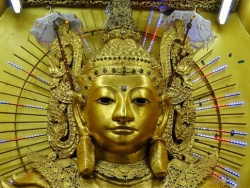Middle Way
The Middle Way or Middle Path (Pali: majjhimā paṭipadā; Sanskrit: madhyamā-pratipad) is the term that Siddhartha Gautama used to describe the character of the path he discovered that leads to liberation.
In Mahayana Buddhism, the Middle Way refers to the insight into emptiness that transcends opposite statements about existence.
Theravada
In the Pali Canon of Theravada (the Dhammacakkappavattana Sutta) to describe the Noble Eightfold Path as a path between the extremes of austerities and sensual indulgence.
Later Pali literature has also used the phrase Middle Way to refer to the Buddha's teaching of dependent origination as a view between the extremes of eternalism and annihilationism.
Noble Eightfold Path
The term Middle Way was used in the Dhammacakkappavattana Sutta, the first teaching that the Buddha delivered after his awakening.
In this sutta the Buddha describes the middle way as a path of moderation, between the extremes of sensual indulgence and self-mortification.
This, according to him, was the path of wisdom.
- Monks, these two extremes ought not to be practiced by one who has gone forth from the household life. (What are the two?)
There is addiction to indulgence of sense-pleasures, which is low, coarse, the way of ordinary people, unworthy, and unprofitable; and there is addiction to self-mortification, which is painful, unworthy, and unprofitable.
- Avoiding both these extremes, the Tathagata (the Perfect One) has realized the Middle Path; it gives vision, gives knowledge, and leads to calm, to insight, to enlightenment and to Nibbana.
And what is that Middle Path realized by the Tathagata...?
It is the Noble Eightfold path, and nothing else, namely: right understanding, right thought, right speech, right action, right livelihood, right effort, right mindfulness and right concentration.
According to the scriptural account, when the Buddha delivered the Dhammacakkappavattana Sutta, he was addressing five ascetics with whom he had previously practiced severe austerities.
Thus, it is this personal context as well as the broader context of Indian shramanic practices that gives particular relevancy to the caveat against the extreme (Pali: antā) of self-mortification (Pali: atta-kilamatha).
Dependent Origination
Dependent Origination (Pratītyasamutpāda) describes the existence of objects and phenomena as the result of causes.
When one cause changes or disappears, the resulting object or phenomena will also change or disappear, as will the objects or phenomena depending on the changing object or phenomena.
Thus, there is nothing with an eternal self or atman, only mutually dependent origination and existence.
But the absence of an eternal atman does not mean there is no-thing at all. Early Buddhism adheres to a realistic approach which does not deny existence as such, but denies the existence of eternal and independent substances.
This view is the Middle Way between eternalism and annihilationism:
- The understanding that sees a 'person' as subsisting in the causal connectedness of dependent arising is often presented in Buddhist thought as 'the middle' (madhyama/majjhima) between the views of 'eternalism' (śaśvata-/sassata-vāda) and 'annihilationism' (uccheda-vāda).
Anatman
Dependent origination views human persons too as devoid of a personal essence or atman.
In Theravadan literature, this usage of the term "Middle Way" can be found in 5th century CE Pali commentaries:
- The Tathāgata teaches the Dhamma by the middle without veering to either of these extremes – eternalism or annihilationism – having abandoned them without reservation. He teaches while being established in the middle way.
What is that Dhamma? By the formula of dependent origination, the effect is shown to occur through the cause and to cease with the cessation of the cause, but no agent or experiencer is described.
In the Visuddhimagga the following is found :
- 'Dependent origination' (paticca-samuppada) represents the middle way, which rejects the doctrines, 'He who acts is he who reaps' and 'One acts while another reaps' (S.ii.20) ..."
In the Pali Canon itself, this view is not explicitly called the "Middle Way" but is literally referred to as "teaching by the middle" (majjhena dhamma).
Rebirth
Conditioned arising also gives a rationale for rebirth:
- Conditioned Arising is a 'Middle Way' which avoids the extremes of 'eternalism' and 'annihilationism': the survival of an eternal self, or the total annihilation of a person at death.
In Theravada Buddhist soteriology, there is neither a permanent self nor complete annihilation of the 'person' at death; there is only the arising and ceasing of causally related phenomena.
Conditioned arising also describes the twelve factors of conditioned origin of suffering (dukkha) leading to rebirth, from ignorance (avijja) to aging and death (jaramarana), and the parallel reverse-order interdependent cessation of these factors (see Dependent Origination and Twelve Nidanas).
Mahayana
Madhyamaka
In Mahayana Buddhism, the Madhyamaka ("Middle Way") school posits a "middle way" position between metaphysical claims that things ultimately either exist or do not exist.
Nagarjuna's influential Verses on the Middle Way deconstructs the usage of terms describing reality, leading to the insight into emptiness. it contains one reference to a sutta by the Buddha himself, namely the Samyutta Nikaya's Kaccāyanagotta Sutta:
- 'Everything exists': That is one extreme.
- 'Everything doesn't exist': That is a second extreme.
- Avoiding these two extremes,
- The Tathagata teaches the Dhamma via the middle...."
Chinese Buddhism
Tendai
In the Tendai school, the Middle Way refers to the synthesis of the thesis that all things are "empty", and the antithesis that all things have phenomenal existence.
Chán
In Chán Buddhism the Middle Way describes the realization of being free of the one-sidedness of perspective that takes the extremes of any polarity as objective reality.
In chapter ten of the Platform Sutra Huineng gives instructions for the teaching of the Dharma.
Huineng enumerates 36 basic oppositions of consciousness and explains how the Way is free from both extremes:
- If one asks about the worldly, use the paired opposite of the saintly; if asking about the saintly use the paired opposite of the worldly.
The mutual causation of the Way of dualities, gives birth to the meaning of the Middle Way.
So, for a single question, a single pair of opposites, and for other questions the single [pair] that accords with this fashion, then you do not lose the principle.


